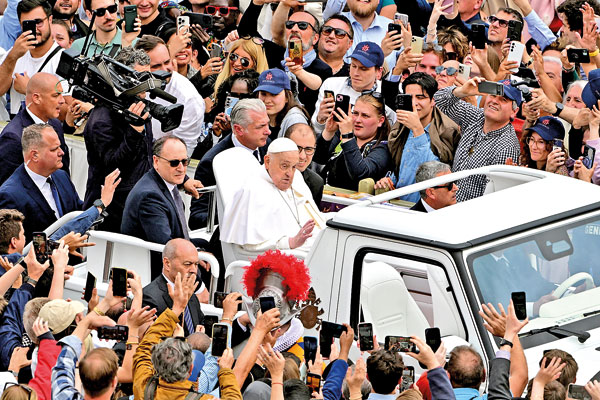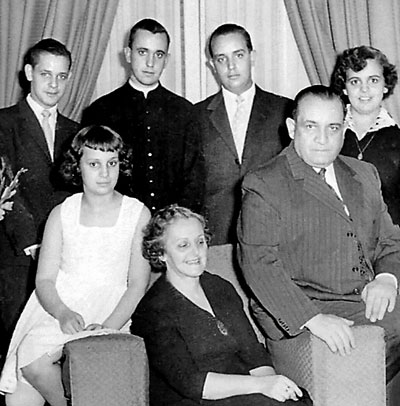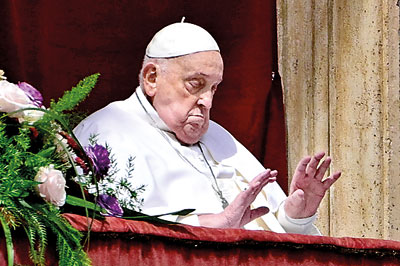Columns
Pope Francis: Not a Prince of the Church but Servant of the People
View(s):- ++SUNDAY PUNCH TRIBUTE TO POPE FRANCIS: THE PEOPLE’S POPE ++
- Who will be chosen by divine will to follow the steps of the people’s Pontiff?
Pope Francis died as he had lived. Simple and humble. From the streets of Argentina, where he had been born and become a priest, to the ascending steps of the opulent Vatican Palace, each rugged step, etched with humbleness and simplicity, had been a testament to his stoic faith. A faith that not riches nor pomp altered a jot.
In his long voyage as a man of God—to be chosen at his final Vatican port as Pope—he shunned the conventional road to walk the spartan path as a Jesuit priest to God. Throughout his journey to the papacy and even thereafter, he remained, in the midst of richly opulence and grandeur, with his Christian soul shrouded in the coarse monastic sackcloth.
In his determined style to veer off the well-beaten track and furrow his own path to tread, he earned a few notable ‘firsts’ on becoming Pope, 12 years ago.
For instance, he became the first Jesuit Pope, and the first, in over thousand years, to take the name Francis in honour of Saint Francis of Assisi. He also became the first Pope from the Americas and from the Southern hemisphere. And when he became Pope, he broke with centuries of tradition when he asked the people, gathered below to receive his benediction, to give him the blessing instead.
He said, “You all know that the duty of the conclave was to give a bishop to Rome. It seems that my brother cardinals have come almost to the ends of the earth to get him… And now I would like to give the blessing, but first I want to ask you a favour. Before the bishop blesses the people, I ask that you would pray to the Lord to bless me—the prayer of the people for their Bishop. Let us say this prayer—your prayer for me—in silence…. I will now give my blessing to you and to the whole world, to all men and women of good will.”
Jorge Mario Bergoglio’s road to the papacy begins in Buenos Aires, among the working class struggling to make a living. His father is from Italy and is an accountant employed by the railways, and his mother—the daughter of Italian immigrants—is a housewife with five children to raise. Jorge Mario is the eldest.
From a young age, he sees, he feels, he lives amidst the poverty that surrounds him in the neighbourhood. It peeps out from every window and seeps from every door to stagnant drains. His heart is drawn toward the suffering the poor endure in wretched dwellings they call home, who look to heaven for release from their miserable existence in slums of Buenos Aires.
At age 16, he is rushing to meet friends but pauses at the Basilica of St. Joseph in Buenos Aires. A sudden urge to go inside comes over him. Within the sanctuary, it feels as though “someone grabbed me from inside,” he says, adding, “Right there I knew I had to be a priest.”
After that mystical experience, with mind made up to serve the poor through God, he sets his heart to become a Jesuit priest and decides to join a seminary.
But youthful zest can be cut down in midflight, and Mario’s struck with a bout of lung infection. It’s serious. He loses half a lung as a result. But rising undaunted when recovered, he joins the seminary at the age of twenty to fulfil his ambitious humanitarian goal to serve the poor and the marginalised, all those rejected as society’s outcasts, as a Jesuit priest.

THE LAST RITE: Pope’s final popemobile tour amongst the people to bid farewell
It takes him 13 years of intense training to become a full-fledged priest of the Order of Jesuits, and when he takes his ordination vows at the age of 33, he resolves, “I do not take these vows to be an ordinary priest but to become an extraordinary priest who makes a difference to the poor’s suffering.”
He continues his training at the University of Alcalá de Henares, Spain, and in 1973 makes his final profession with the Jesuits. Soon he becomes the head of Argentina’s Jesuits. But it’s a terrible time for both country and the church. Argentina is plunged into violence and a ‘dirty civilian war’ ensues.
The ruling military junta tortures, kills or simply makes ‘disappear’ as many as 30,000 people. Later, Father Bergoglio faces accusations that he had done naught to protect two priests, kidnapped and tortured by Argentina’s military regime. Anyone who holds political and ideological views against the junta is considered a ‘threat’ and is bumped off by the junta’s ‘death squads’.
Father Bergoglio denies the accusations and insists he protected priests and others behind the scenes by contacting military officers and pressing them to get those held in their custody freed. But it’s to no avail. In 1979, even as the ‘dirty war’ comes to an end, so does his tenure as head of the Jesuits come to a close, wrapped in controversy. Church superiors send him to exile in Frankfort, Germany, and later to Córdoba, Argentina.

THE FAMILY ALBUM: Father Bergoglio with his mother and father and his four siblings
But destiny defies the temporal potency of the Church. As he spends his exile, a divine light shines from the Holy See. Pope John Paul II has been watching the rise of the Jesuit priest and his subsequent fall into a rural exile. The time has dawned for Father Mario Bergoglio’s resurrection.
His star is in the ascendant. In 1992, Pope John Paul II appoints him as titular Bishop of Auca and Auxiliary of Buenos Aires. In 1993 he’s given the office of Vicar General of the Archdiocese. Four years later, he’s raised to the position of Coadjutor Archbishop of Buenos Aires.
With ranks and positions—which he has always shunned—flowing swiftly to him by divine will, nine months later, he is, on the death of Buenos Aires Archbishop Cardinal Quarracino, elevated to the rank of Archbishop, Primate of Argentina.
But even more clerical rank and position await Father Bergoglio. Three years later, Pope John Paul II elevates him further by placing him on the pedestal as a cardinal of the Roman Catholic Church. With this he gets new billing as a possible contender to the throne of St Peter.
In October that year, Cardinal Bergoglio addresses the Synod of Bishops in Rome. The topic, ‘The Bishop: Servant of the Gospel of Jesus Christ’. He views the bishop’s mission as one ‘prophetic’ and the bishop as a ‘prophet of justice’, with his duty being to ‘preach ceaselessly’ the social doctrine of the Church; and ‘to express an authentic judgement in matters of faith and morals’.
On April 2, 2005, a week after Easter Sunday, Pope John Paul the Second breathes his last on a hospital bed. Following his demise, the Cardinal Conclave—of which he, too, is a member—meeting at the Sistine Chapel, prays for divine succour to choose the next Supreme Pontiff. On the fourth vote, the Cardinals elect Cardinal Ratzinger as the new Pope. He takes the name of Benedict.
Alas, his reign as Pope does not last long. It ends in 2013. It is cut short not by death but by retirement. It’s unprecedented. Not since the 15th century had any Pope retired but had remained as Pope till death. Here was a Pope who had not died but decided to fade away. The era of double Popes in the Vatican is about to unfold.
Pope Benedict XVI’s retirement, citing advancing years, paves the way for a new Pope to sit on the vacant throne of St Peter.
Once again the Cardinals meet in conclave at the Sistine Chapel on March 12 that year. By the 13th afternoon, four ballots have produced only black smoke. But when the fifth ballot causes white smoke to pour out from the chapel chimney, a roar of applause breaks out amongst the crowd, assembled outside at St Peter’s Square.
The divine will expressed through the Conclave of Cardinals gives Rome a new bishop and the world a new Pope. Cardinal Bergoglio becomes the new Pope, the 266th since Jesus told Peter, ‘You are Peter, and upon this rock I will build my church’.
For the next twelve years of his papacy, Pope Francis places emphasis on mercy and compassion, focuses on social justice and seeks reform of the Church from within. He condemns corruption and inequality wherever found. He reaches out to the poor, to migrants and refugees, to the underprivileged, and to society’s discards. He travels to over 60 countries, preaching his Christian message of love to all mankind.
And for the manifold humble acts that litter his papacy, the people themselves bestow on him the mantle: Francis, The People’s Pope.
Though he does not give his consent to gay marriages, he asks, ‘Who am I to judge?’ And gives his blessing to gay couples. Though during his 12-year tenure as Pope, the lyrics may have changed, the music of the Christian doctrine remains the same.
The papal legacy he leaves behind will be studied, debated and discussed for many years to come. His lasting legacy is how he lived the Joys of The Gospels throughout his life.
| The power of the Pope’s ‘Urbi et Orbi’ benedictionWhen at the end of his Easter Sunday message, Pope Francis delivered his blessing, ‘Urbi et Orbi’, the meaning and significance of this sacred benediction from the lips of the Pope, wouldn’t have been lost on the faithful, who were gathered below at St Peter’s Square last Sunday. In fact, many of the devout may have come to St Peter’s Square to specifically receive the Pope’s Easter Sunday benediction. The meaning of ‘URBI ET ORBI’ is simple enough for anyone to understand. It simply means, blessings ‘to the city of Rome and to the world.’ What gives the blessing its special uniqueness is that it can only be delivered by the Pope. No Cardinal nor Bishop nor a parish priest has the authority to give the ‘Urbi et Orbi’ blessings at any mass on any occasion, however special it may be. If they dare to usurp the sole right of the Pope, they run the risk of committing profanity. The blessing is exclusively reserved for the Holy Father to give, and no other cleric, however exalted in rank or position, in the Catholic Church, can trample upon the monopolistic preserve of the Pope.  POPE FRANCIS: Delivers last Sunday, Easter Sunday’s ‘Urbi et Orbi‘ blessing But even the Pope can give the blessing only sparingly, not toss it around like confetti at a wedding ceremony. Following traditions dating back to Middle Ages, the Pope delivers the sacred divine ‘Urbi et Orbi’ blessing from the balcony of St. Peter’s Basilica on Easter Sunday and on Christmas Day at noon. By not turning the holy blessing into a common cliché through frequent use, these three Latin words, ‘Urbi et Orbi’, gain a profound, powerful effect by being seldom delivered by the Pontiff, other than at the two important days in the Christian calendar, celebrating the Birth and the Resurrection of Jesus Christ. However, the rigid rule has its exceptions. When world disasters or pandemics break out that affect the catholic community at large, the Pope parts from the rule, and delivers the ‘Urbi et Orbi’ benediction. One such notable instance of the historic blessing being delivered by Pope Francis was on March 27, 2021 on the steps of St. Peter’s Square, to pray for the end of the COVID pandemic. He delivered the powerful blessing in the presence of two images that have accompanied the people of Rome for centuries, namely, the ancient icon of Mary Salus Populi Romani and the miraculous crucifix kept in the church of San Marcello. Who knows? The decline and end of the COVID pandemic may have been due to the Pope’s timely invocation of the ‘Urbi et Orbi’ benediction to the horribly COVID affected city of Rome and to the world. As Shakespeare’s Hamlet says: “There are more things in heaven and earth, Horatio, than are dreamt of in your philosophy”.
| |
Buying or selling electronics has never been easier with the help of Hitad.lk! We, at Hitad.lk, hear your needs and endeavour to provide you with the perfect listings of electronics; because we have listings for nearly anything! Search for your favourite electronic items for sale on Hitad.lk today!


Leave a Reply
Post Comment